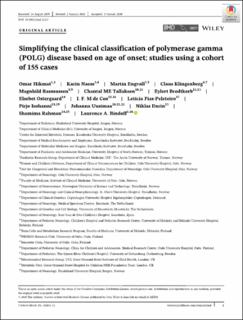Simplifying the clinical classification of polymerase gamma (POLG) disease based on age of onset; studies using a cohort of 155 cases
Hikmat, Omar; Naess, Karin; Engvall, Martin; Klingenberg, Claus; Rasmussen, Magnhild; Tallaksen, Chantal; Brodtkorb, Eylert; Østergaard, Elsebet; de Coo, Irenaeus F.M.; Pias-Peleteiro, Leticia; Isohanni, Pirjo; Uusimaa, Johanna; Darin, Niklas; Rahman, Shamima; Bindoff, Laurence
Journal article, Peer reviewed
Published version

Åpne
Permanent lenke
https://hdl.handle.net/11250/2733319Utgivelsesdato
2020Metadata
Vis full innførselSamlinger
- Department of Clinical Medicine [2066]
- Registrations from Cristin [9791]
Sammendrag
Background
Variants in POLG are one of the most common causes of inherited mitochondrial disease. Phenotypic classification of POLG disease has evolved haphazardly making it complicated and difficult to implement in everyday clinical practise. The aim of our study was to simplify the classification and facilitate better clinical recognition.
Methods
A multinational, retrospective study using data from 155 patients with POLG variants recruited from seven European countries.
Results
We describe the spectrum of clinical features associated with POLG variants in the largest known cohort of patients. While clinical features clearly form a continuum, stratifying patients simply according to age of onset—onset prior to age 12 years; onset between 12 and 40 years and onset after the age of 40 years, permitted us to identify clear phenotypic and prognostic differences. Prior to 12 years of age, liver involvement (87%), seizures (84%), and feeding difficulties (84%) were the major features. For those with onset between 12 and 40 years, ataxia (90%), peripheral neuropathy (84%), and seizures (71%) predominated, while for those with onset over 40 years, ptosis (95%), progressive external ophthalmoplegia (89%), and ataxia (58%) were the major clinical features. The earlier the onset the worse the prognosis. Patients with epilepsy and those with compound heterozygous variants carried significantly worse prognosis.
Conclusion
Based on our data, we propose a simplified POLG disease classification, which can be used to guide diagnostic investigations and predict disease course.
